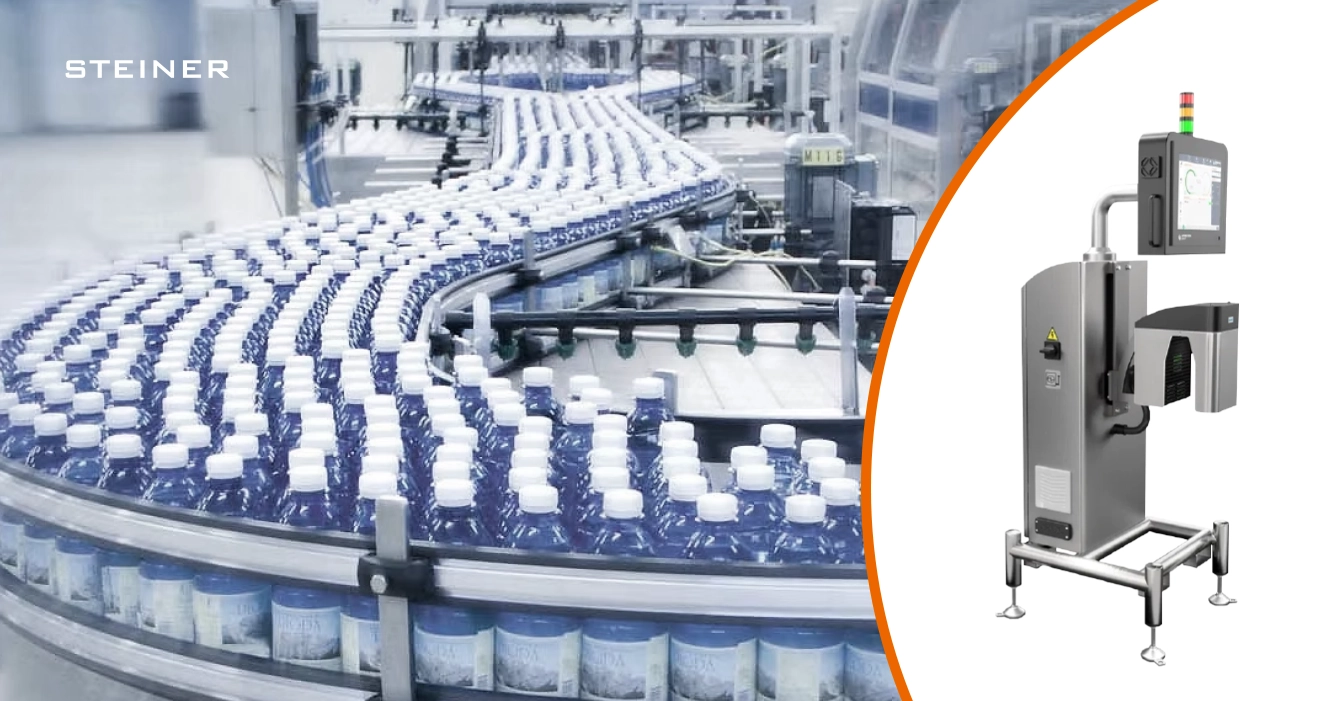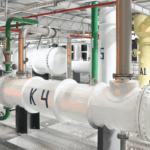In today's food and beverage manufacturing world, safety and quality are non-negotiable requirements. For manufacturers of beverages, sauces, and yogurts, detecting foreign contaminants in hermetically sealed products—PET bottles, glass jars, or plastic cups—remains a serious challenge. Traditional inspection methods, such as metal detectors and X-ray systems, do not always do the job, especially when it comes to non-metallic contaminants such as plastic, wood, rubber, or insects. Microwave inspection is a revolutionary technology that fills these gaps, offering unmatched detection capabilities for liquid and semi-liquid products. This article reveals how microwave inspection is transforming quality control, why it is indispensable for manufacturers, and how Steiner is delivering this cutting-edge technology to raise production standards.
Hidden risks in liquid and semi-liquid products
Foreign contamination in packaged food and beverages is an inevitable reality. Data from the Rapid Alert System for Food and Feed (RASFF) shows that contaminants such as plastic, wood, glass, and organic materials often go undetected by traditional inspection systems, leading to costly recalls, consumer complaints, and reputational damage. In 2023 alone, more than 300 incidents related to physical contamination of products were reported in the EU, a significant proportion of which involved non-metallic materials. For manufacturers of beverages (water, juices, RTD drinks), sauces (ketchup, dressings), and yogurts, the stakes are extremely high. One unnoticed contaminant can cost millions in losses and undermine consumer confidence.
Traditional inspection technologies have limitations:
- Metal detectors: Effective for detecting ferrous and non-ferrous metals, but cannot detect non-metallic contaminants such as plastic, wood, or insects. They also suffer from the “product effect” in products with high moisture or salt content, which leads to false positives.
- X-ray systems: Detects metals and some dense materials such as glass or bones, but is less effective for low-density materials such as wood, rubber, or lightweight plastic. X-rays require shielding due to ionizing radiation, which complicates operation.
- Visual control: Limited by human factors and ineffective for opaque packaging, making it unreliable for high-speed lines.
Microwave inspection overcomes these challenges by offering a reliable solution for detecting a wide range of contaminants with high accuracy, safety, and efficiency.
How microwave inspection works
Microwave inspection uses the principle of dielectric contrast to detect foreign objects. Unlike X-ray systems, which rely on density differences, or metal detectors, which depend on conductivity, microwave technology measures changes in the dielectric properties of a product caused by the presence of foreign materials. Here's how it works:
- Signal radiation: The system sends a low-power microwave signal (approximately 1 mW, 100 times less than a mobile phone) through the product and its packaging.
- Analysis of dielectric properties: Sensors register changes in the electric field caused by differences in dielectric permeability between the product and foreign material. For example, a plastic fragment in a yogurt cup changes the dielectric properties differently than a homogeneous yogurt mass.
- High-speed processing: Modern artificial intelligence (AI) algorithms analyze data in real time, detecting contaminants as small as 1 mm in less than 100 milliseconds. The system can process up to 600 units per minute, easily integrating into high-speed production lines.
- 3D reconstruction: The technology creates a three-dimensional map of the location and type of contamination, minimizing false positives and ensuring accurate removal of contaminated products.
This non-invasive technology without ionizing radiation is safe for operators, products, and the environment, requiring no special shielding or cooling systems. It is particularly effective for homogeneous liquid and semi-liquid products in non-metallic packaging, such as PET bottles, glass jars, plastic cups, or flexible bags.
Why microwave inspection is essential for manufacturers
For manufacturers of beverages, sauces, and yogurts, microwave inspection offers unique advantages that solve key problems:
1. Unsurpassed detection of contaminants
Microwave inspection detects a wide range of foreign objects that traditional systems miss, including:
- Metals: Black, colored, and stainless steel.
- Non-metals: Plastic (transparent or black), wood, rubber, glass, bones, chitin particles, insects.
- Low-density materials: Lightweight plastic or organic materials that X-rays often fail to detect.
Comparison of detection capabilities:
| Type of contamination | Metal detector | X-ray | Microwave inspection |
| Metal | ✅ | ✅ | ✅ |
| Plastic (transparent/black) | ❌ | ❌/⚠ | ✅ |
| Wood | ❌ | ❌ | ✅ |
| Glass | ❌ | ⚠ | ✅ |
| Rubber/gaskets | ❌ | ❌ | ✅ |
| Bones/chitinous fragments | ❌ | ⚠ | ✅ |
| Insects | ❌ | ❌ | ✅ |
2. Seamless integration into production lines
Microwave inspection systems are designed for high-speed operation in a flow, scanning products in 100 milliseconds. They are easily integrated into existing production lines, supporting formats such as PET bottles, glass jars, plastic cups, and flexible bags. The flexibility of the technology allows inspection parameters (such as antenna frequency and placement) to be customized for specific products and packaging types.
3. Improved safety and compliance with standards
Unlike X-ray systems, microwave inspection uses non-ionizing radiation, which poses no risk to operators or products. Low energy consumption (compared to a Wi-Fi router) ensures environmental sustainability. The technology complies with the principles of hazard analysis and critical control points (HACCP), helping manufacturers meet strict safety standards such as IFS, BRC, and FDA.
4. Economic risk minimization
A single product recall can cost millions in direct costs and lost revenue. Microwave inspection minimizes this risk by detecting contaminants that other systems miss, protecting brand reputation and consumer trust. AI-powered accuracy reduces false rejects, minimizing product waste and improving operational efficiency.
5. Versatility for different applications
Microwave inspection is ideal for homogeneous liquid and semi-liquid products, including:
- Beverages: Water, juices, RTD beverages, and functional beverages in PET or glass.
- Yogurts and desserts: Creams, yogurts, puddings in plastic cups or jars.
- Sauces and condiments: Ketchup, dressings, sauces in bottles, jars, or packets.
- Mashed potatoes and baby food: Homogenized products in trays or flexible packaging.
The technology is less effective for all-metal packaging (e.g., tin cans), but specialized antenna arrays allow for the inspection of packaging with metal lids, such as screw caps or aluminum foil.
Why manufacturers cannot ignore microwave inspection
For manufacturers of beverages, sauces, and yogurts, the price of inaction is high. One unnoticed contaminant can lead to:
- Financial losses: A recall can cost millions in direct costs, logistics, legal fees, and lost revenue.
- Reputational damage: A negative reputation undermines consumer confidence, affecting market share.
- Regulatory sanctions: Failure to comply with product safety standards may result in fines and production stoppages.
Microwave inspection does not replace X-ray or metal detectors, but complements them, creating a comprehensive quality control ecosystem. By integrating microwave inspection at critical control points (CCPs), manufacturers can achieve:
- Comprehensive protection: Detection of both metallic and non-metallic contaminants, ensuring that no threat goes unnoticed.
- Operational efficiency: High-speed scanning and low false rejection rates minimize downtime and losses.
- Consumer confidence: Providing consistently safe and high-quality products strengthens brand loyalty.
Steiner: your partner in quality assurance
Steiner is a leader in providing microwave inspection solutions tailored to the needs of beverage, sauce, and yogurt manufacturers. The technologies we offer are designed for seamless integration into new and existing production lines, implementing:
- Customized solutions: Systems adapted to specific product types, packaging formats, and production speeds.
- Expert support: Comprehensive consulting and ongoing maintenance to ensure optimal performance.
By partnering with Steiner, manufacturers gain access to technology that not only meets but exceeds industry standards, protecting their products and reputation.
Conclusions: the future of food safety
In an industry where consumer safety and brand integrity are paramount, microwave inspection marks a paradigm shift. By detecting contaminants that traditional systems miss, it enables manufacturers to achieve unparalleled quality control. For beverage, sauce, and yogurt manufacturers, implementing this technology is not just an investment in compliance, but a commitment to excellence. Steiner is ready to guide you through this transformation, providing solutions that protect your products, your brand, and your customers.
Contact Steiner today to learn how microwave inspection can take your production line to new heights of safety and efficiency.



